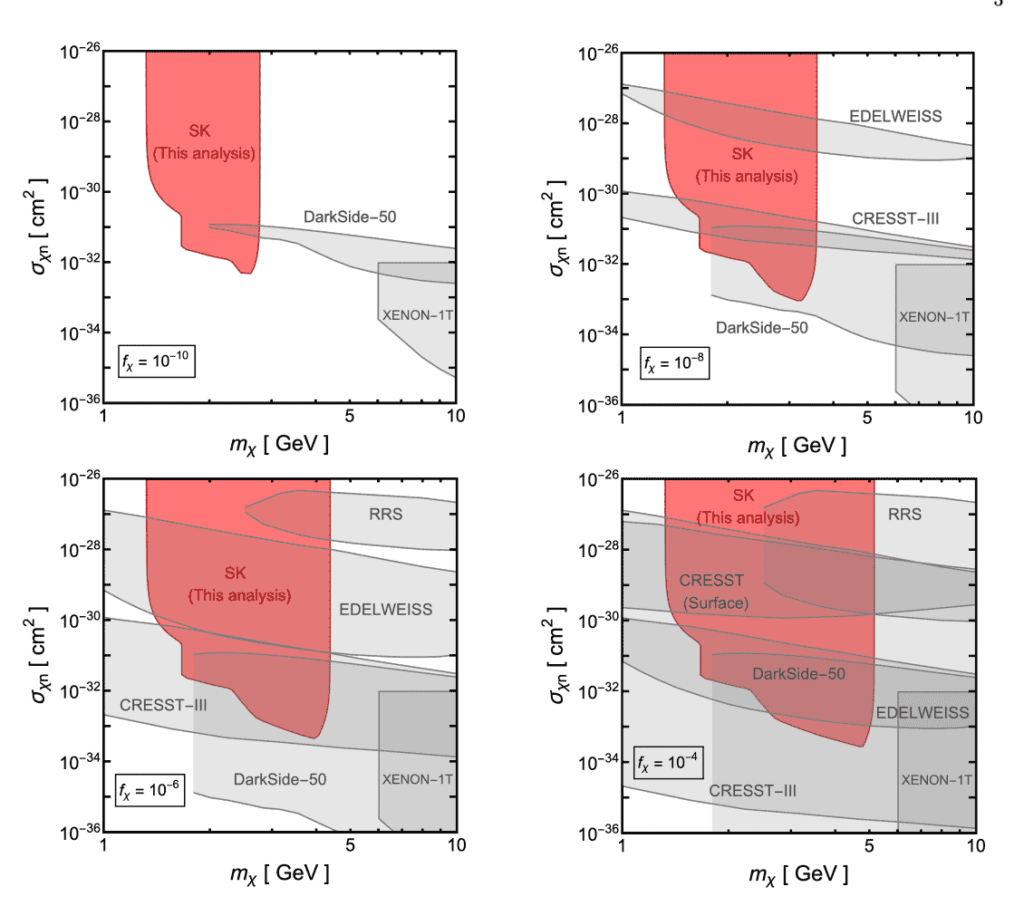Dark Matter Annihilation can turn on the lights inside neutrino detectors
Prepared by Anupam Ray
Incontrovertible evidence of a non-baryonic form of matter, commonly known as dark matter (DM), constituting ~27% of the energy-budget of the Universe, has firmly been established by several cosmological observations. Despite its enormous abundance, we are yet to decode the microscopic identity of such non-baryonic form of matter.
While DM might consist of just a single new particle, it could also be composed of several. In fact, many theories of new physics beyond the Standard Model predict one or more such stable particles, each of which could contribute to the total density of DM. In this work, we concentrate on a DM component (which we refer as ![]() ) that interacts sufficiently strongly with ordinary matter but that makes up only a tiny fraction of the total DM mass density, and the key question is: how to detect such DM particles?
) that interacts sufficiently strongly with ordinary matter but that makes up only a tiny fraction of the total DM mass density, and the key question is: how to detect such DM particles?
Traditionally, detection of such particles turns out to be extremely challenging because a strongly interacting dark matter component would be slowed significantly by scattering with matter in the atmosphere or the Earth before reaching the target, leading to energy depositions in the detector that are too small to be observed with the standard experimental methods.
In this work, which recently published in Physical Review Letters, we propose a simple yet novel detection scheme of such DM particles. Owing to their sufficiently large scattering cross-section with the stellar nucleons, a strongly-interacting dark matter component would be trapped readily in the Earth and quickly thermalize with the surrounding matter. Because of the enormous size of the Earth and cosmologically long lifetime, their terrestrial density can be tantalizingly large, up to ![]() orders of magnitude larger than the local Galactic DM density. Furthermore, if they are sufficiently light (~ GeV scale), they distribute almost uniformly over the the entire Earth volume, rather than concentrating towards the core, making their surface-density quite large. This naturally results in an enormous abundance of
orders of magnitude larger than the local Galactic DM density. Furthermore, if they are sufficiently light (~ GeV scale), they distribute almost uniformly over the the entire Earth volume, rather than concentrating towards the core, making their surface-density quite large. This naturally results in an enormous abundance of ![]() particles inside large-volume neutrino detectors, such as, Super-Kamiokande, a large-scale Cherenkov detector located under Mount Ikeno in Japan. Annihilation of
particles inside large-volume neutrino detectors, such as, Super-Kamiokande, a large-scale Cherenkov detector located under Mount Ikeno in Japan. Annihilation of ![]() particles to visible matter inside fiducial volume of Super-Kamiokande can induce observable signatures, and by searching these annihilation products one could provide unprecedented sensitivity to DM interactions.
particles to visible matter inside fiducial volume of Super-Kamiokande can induce observable signatures, and by searching these annihilation products one could provide unprecedented sensitivity to DM interactions.
We demonstrate that, even if these ![]() particles make up a minuscule fraction of the DM-density, our proposed method provides world-leading exclusions on DM interactions. More specifically, we show that
particles make up a minuscule fraction of the DM-density, our proposed method provides world-leading exclusions on DM interactions. More specifically, we show that ![]() particles in the mass range of (1−5) GeV can be efficiently constrained via existing Super-Kamiokande searches for di-nucleon annihilation (see Fig. 1). The main strength of this proposal simply stems from the fact that the energy deposition due to annihilation of Earth-bound DM is not limited by their minuscule amount of kinetic energy, but can instead be as large as their invariant mass, naturally provides a dramatic signal for detection of the relic. We are also hopeful that with the upcoming gigantic underground detectors such as, Hyper-Kamiokande, JUNO, DUNE, and THEIA will significantly enhance the detection prospects of such strongly-interacting dark matter component.
particles in the mass range of (1−5) GeV can be efficiently constrained via existing Super-Kamiokande searches for di-nucleon annihilation (see Fig. 1). The main strength of this proposal simply stems from the fact that the energy deposition due to annihilation of Earth-bound DM is not limited by their minuscule amount of kinetic energy, but can instead be as large as their invariant mass, naturally provides a dramatic signal for detection of the relic. We are also hopeful that with the upcoming gigantic underground detectors such as, Hyper-Kamiokande, JUNO, DUNE, and THEIA will significantly enhance the detection prospects of such strongly-interacting dark matter component.

Header image: Super-Kamiokande neutrino detector. Courtesy Kamioka Observatory, ICRR (Institute for Cosmic Ray Research), The University of Tokyo
Read More:

